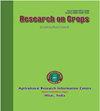研究生长抑制剂对燕麦生长和产量的影响
Q3 Agricultural and Biological Sciences
引用次数: 0
摘要
由于人口数量的大幅增加、气候变化及其对农业生产造成的问题(如干旱、洪水和飓风),粮食安全成为世界各国面临的一项重大挑战。大多数燕麦品种的特点是茎秆较长,这使其成为沉积干物质的有效 "水槽",在使用生长抑制剂(如 Cycocel 和乙烯)抑制茎秆纵向生长并增加其直径,以及增加有效分枝数量的情况下,干物质可以直接沉积到谷物中,降低了结荚的风险,从而提高了谷物产量。该实验于 2020-2021 年冬季在巴格达大学农业工程科学学院的田间进行,目的是评估生长抑制剂 Cycocel )CCC( 和电石 CaC2(可产生乙烯)的效果,采用了随机完全区组设计(RCBD)的三次重复,共测试了 8 种处理,包括喷洒浓度为 200、400 和 600 毫克/升的 CCC 和地面施用 2 克/株的 CaC2(单独施用和混合施用)。研究结果表明,与对照处理相比,所有处理都能提高谷物产量,降低植株高度。值得注意的是,C600 + CaC2 处理在谷物产量(5.52 吨/公顷)、总干物质(20.14 吨/公顷)和收获指数(25.21)方面明显优于其他处理。这些结果表明,生长抑制剂可有效调节源-汇关系,从而提高谷物产量。本文章由计算机程序翻译,如有差异,请以英文原文为准。
Investigating the influence of growth inhibitors on the growth and yield of oat (Avena sativa)
Food security is a major challenge faced by countries around the world due to the large increases in population numbers, climate change, and the problems it causes in agricultural production, such as droughts, floods, and hurricanes. Most oat varieties are characterized by their long stems, and this makes them effective Sink for the deposition of dry matter that can be directed to the grain in the case of the use of growth inhibitors (such as Cycocel and ethylene) that suppress the longitudinal growth of the stems and increase its diameter, as well as increase the number of effective branches, reduces the risk of lodging, thus increasing the grain yield. This experiment was conducted in the fields of the College of Agricultural Engineering Sciences, University of Baghdad, during the winter season of 2020-2021, to assess the effects of growth inhibitors Cycocel )CCC( and calcium carbide CaC2 (which generates ethylene), used three replications of a randomized complete block design (RCBD), Eight treatments were tested, including spraying CCC at concentrations of 200, 400, and 600 mg/L and ground application of CaC2 at 2 g/plant individually and in combination. The findings revealed that all treatments led to an increase in grain yield and a decrease in plant height compared to the control treatment. Notably, the C600 + CaC2 treatment exhibited significant superiority over other treatments in grain yield (5.52 t/ha), total dry matter (20.14 t/ha), and Harvest Index (25.21). These results suggest that growth inhibitors can effectively modulate the source-sink relationship, thereby enhancing grain yield.
求助全文
通过发布文献求助,成功后即可免费获取论文全文。
去求助
来源期刊

Research on Crops
Agricultural and Biological Sciences-Soil Science
CiteScore
1.50
自引率
0.00%
发文量
93
审稿时长
1 months
期刊介绍:
The Research on Crops is a peer-reviewed journal publishing original research papers, review articles and short communications in English on all basic and applied aspects of crop sciences, agricultural water management, agro-climatology, agroforestry, agronomy, crop production, crop protection, cropping systems, food science & technology, genetics & plant breeding, horticulture, plant & soil science, plant biotechnology, plant nutrition, post-harvest management of crops, seed science, soil management & tillage, vegetables, weed science, agricultural engineering, agri-business, agricultural economics and extension, etc. The aim of the journal is to provide a forum for the scientific community to publish their latest research findings.
The manuscripts submitted for publication should not contain data older than 4 years on the date of submission.
The articles submitted for publication in this journal should not be submitted elsewhere simultaneously for publication in another journal. These should not carry any copyright material without prior permission of copyright holder.
The articles should present a complete picture of the investigation made and should not be split into parts.
There is no prescribed limit regarding the number of pages in case of full-length articles. However, the authors are advised to keep the length of their articles from 4 to 10 full printed pages of the journal.
The articles should be divided into the sub-sections: ABSTRACT, INTRODUCTION, MATERIALS AND METHODS, RESULTS AND DISCUSSION, CONCLUSIONS, and REFERENCES. Tables and figures should be appended separately at the end.
 求助内容:
求助内容: 应助结果提醒方式:
应助结果提醒方式:


